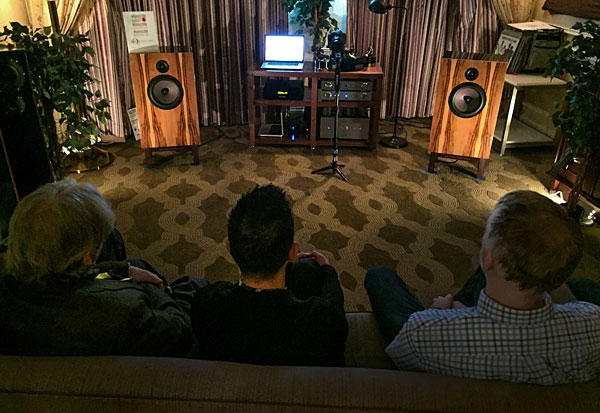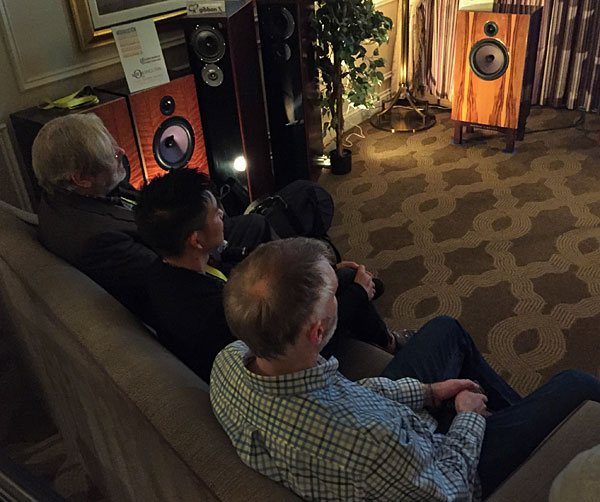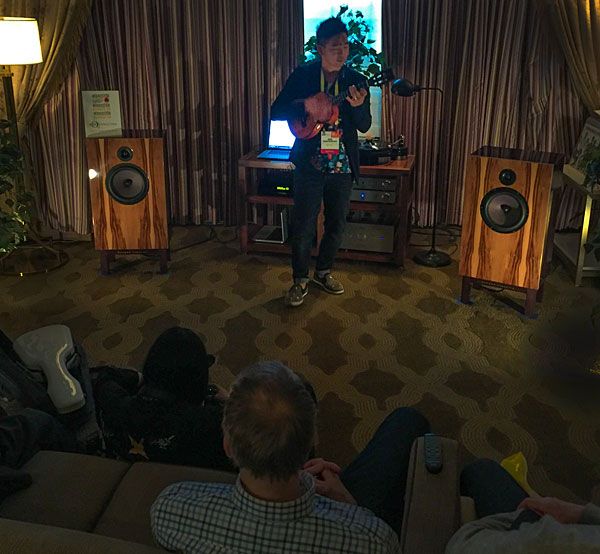| Columns Retired Columns & Blogs |
This proves Jake has a good ear.

You can see John Atkinson on the couch at left and John DeVore to Jake's right. Also in the small room, but not in the photos, were some visitors including a couple rabid Jake fans that heard he was in the 'hood and had brought vinyl copies of Nashville Sessions. I had visited John the day before Jake's visit (as I did with all the rooms) and he picked out and set up the pair of speakers he felt were best suited to Jake's music, the Orangutan O/96. I couldn't agree more.
I again set up the laptop with Jake's HiRez files and tested. We are ready to go, and Jake decided to crank up the volume a little--and it sounded superb! These speakers can clearly handle dynamic bottom end. Again the same tracks: "Blue Haiku" and "Galloping Seahorse", and the tighter quarters created a more near-field presentation.

Jake: "What I really love about these speakers is how they convey the tone of the instrument. Very natural, very warm. Some of the other systems you can get distracted by the soundstage or imaging, but this one, man, this is closest to what it sounded like in the studio when we were mixing. Because of the nature of the setup the sound is coming more directly at you versus some of the other ones. This is how I'm more used to hearing music."
John Devore: "The bass tone was beautiful, the recording sounded really excellent." Then everyone in the room commented that "the sound of the ukulele was gorgeous." Jake: "I'm really interested in what 'Eleanor Rigby' will sound like here", and DeVore quickly added, "me too!"
When Jake played this room, it felt very much like an intimate house concert, and our closer proximity to his instrument, and the smaller dimensions, changed how "Eleanor Rigby" came across, revealing even more subtle detail and tone. Again, when the digital version of "Eleanor Rigby" was played, you could hear the mic's character and dry nature of the recording, but the body of the instrument also came through.
Jake: "With this system again, very warm, very natural. And this is now the sixth room we've done this and there has been this common thread in all the systems when we do this experiment, and it always feels that with the live performance there's a lot more top end and airiness. And I'm realizing that a lot of it is the nature of the vintage Neumann KM84s, the characteristics of those microphones, but I also notice the dynamic compression in the recording--it should be very similar to how I play it live, but I find that it just doesn't translate."

John Devore then asks "do you mean the performance dynamics or the raw dynamics of the sound coming off of the instrument?" Jake: "the [Performance] dynamics of how I play it live--which are the same dynamics of how I played it on the recording, but it just doesn't translate in all the places we've played. But the frequencies of the ukulele are really sweetened by these speakers. I feel like there is no harshness to it. They are just great!"
Devore: "Yes I heard it the same way. The recording had a bit less top, but maybe that was a perception, since I feel that it had more midrange, which is perhaps a mic or proximity effect. That's the kind of quality where [the mics] were picking up more of the wood, but we're not in a resonant room, so we're hearing more of the string."
JA: "You hear more of his fingers on the strings live."
Devore: "Exactly, and I think that just wasn't picked up. As you know, that can be very much a mic placement thing--the string sound is beaming straight out and the wood sound is going everywhere. And the dynamics, I think the expressive dynamics are what you are talking about, and then there is also the dynamics of the sound, of you hitting it, and I think that was in the sound that was recorded and coming off the instrument. But I felt like the recording didn't diminish as much as when you were playing. You could back off of the tone, and show us what you mean, and with the recording I found it didn't really back away as much, it stayed up a little bit more dynamically. Very interesting though--cool!"
DeVore Fidelity Music Equipment List:
DeVore Fidelity Orangutan O/96 speakers (what Jake heard) $12,000/pr
DeVore Fidelity gibbon X speakers $15,800/pr
DeVore Fidelity Orangutan O/93 speakers $8,400/pr
EMT JSD-S75 Moving Coil Cartridge pre-mounted in EMT J-Shell $5,400
EMT 997 Tonearm $5,495
EMT TSD-75 Moving Coil Cartridge $2,100
Brinkmann 10.5 Tonearm $5,490
Brinkmann Spyder Turntable with 2 Arm Pods $14,400
Sugden Masterclass PA-4 Phono Preamplifier $2,500
TotalDac D1 Tube Mk II DAC $11,000
Sugden Masterclass LA-4 Line Preamplifier $3,750
Sugden Sapphire FBA800 40/WPC Class A Amplifier $7,500
Box Furniture Co HD3W Walnut Double-Wide 3 Shelf Equipment Stand $5,500
Auditorium 23 RCA & XLR Interconnects 1.0 meter $795
Auditorium Speaker Cables 2.5 meters $980
More info on Jake @CES here. You can read all of the Jake @CES posts here.

IMVHO (very humble) I think that the variables are any microphones, even the best take time to react to the sound being recorded. No matter how light the diaphragm there is a micro-second(s) of time lost to get the mass moving. In amplifiers it is slew rate...how fast can the amp react to the input. Is there overshoot? We've seen it in JA's measurements of amplifiers of the square waves. There is not a perfect microphone, mic preamp, amp, ADC and DAC and all that matters when compared to the "real, live performance". Those of us who love to record things now we have put a lot of stuff between "live and recorded". If you were there, there was nothing between you and Jake's playing.
Mic placement is a big part of it and how many and where do we put them to get the sound that we want? I have found that I love on acoustic instruments, guitars, violins, cells, etc. a pair of mics spaced about a foot apart panned hard left and right in the stereo spread and then work to find the right distance from the performer they like. If I use my multi-track recorder on mix down I can then choose if I want to keep the max spread of the stereo mics or close them in to what the performer prefers. If I also add a spaced pair further back and high, I can then add as much of the "room" as they like.
The pair of close mics provide a larger sense of scale the more I stay hard left and right. With the right speakers you can make a guitar sound very large, that sense of scale we all seem to miss from live events compared to the recording.
One variable in all of this is the ambient noise of the room and I think that is often not taken into account enough, plus the inherent noise floor of the mics (My Rode NT-1As have only 5db of self noise, but they may not be everyone's cup of tea, and many are 15 to 20db.) and all the recording electronics adds up. The ambient noise in the room is a big deal. We worry about quiet electronics and that theoretic -96db noise floor of 16 bit and -144db for 24 bit, but the room makes all of that just a science project as I am thrilled if I can get close to -78db to -80db in a room. In this case the listeners probably were well aware of the background noise of the room.
I am sure all that had a chance to be there enjoyed that demo and Jake's great playing. I would also bet that 5 recording engineers would get 5 different sounding recordings of the same event. That will never change.
